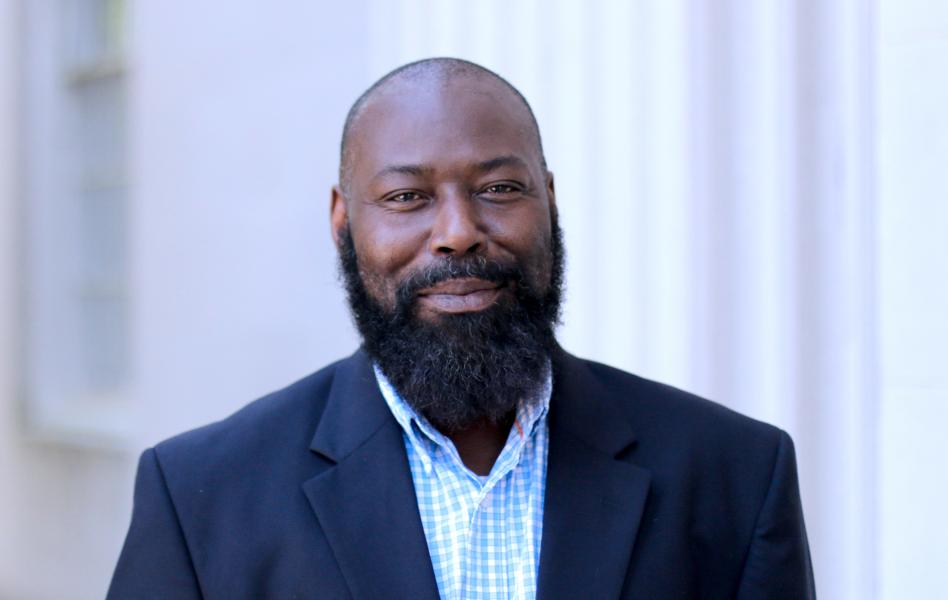
H.G. Jones, photo courtesy of NCCCHA
When H.G. Jones died on October 14, our state lost a key connection to its history as well as a prime and positive, but all too rare, example of dedicated and unselfish public service.
For many years Jones was my neighbor. I admired the fruit tree in his front yard across the street from my house on Country Club Road in Chapel Hill. It was an uncommon variety of apple named “Mattamuskeet.” Its small, dark-colored fruit was not as alluring as the flashy golden varieties in the grocery stores, nor was its flesh as super sweet and tasty as the varieties we have come to love so much. Mattamuskeets are tough and tangy, part of the adapted attributes that equip them to withstand the challenges of storage in the warm and moist conditions of the coastal plain of North Carolina. For that reason alone, it is treasured by people who live in Hyde County near the lake that shares the Mattamuskeet name.
According to legend, the seed of the first such tree was found ages ago by Mattamuskeet Indians in the gizzard of a large goose.
Walking by Jones’s house during the fall, I would sometimes steal a few apples that had fallen. Then I would make apple cobbler, take a serving to Jones, and ask for his forgiveness for my theft. He always forgave, always with a smile.
How that Mattamuskeet apple tree got to Jones’s yard is one of my favorite stories.
In his role as director of North Carolina’s Department of Archives and History and later as curator of the North Carolina Collection at the UNC-Chapel Hill library, Jones was often asked to travel to various parts of the state to lecture to local groups about their community’s history. Usually, the group offered him a small honorarium. He always refused, explaining that he was a public servant and had already been paid to promote the history of our state.
Although he always refused any monetary payment, it came to be known that he would accept an apple pie, if one were offered. So it became customary for local groups to present him with a pie after every talk.
Once, he traveled to Hyde County to give a talk. Surprisingly, no pie was presented — and Jones came back to Chapel Hill empty-handed and a little puzzled about the missing pie.
Several days later, when he came home from work, Jones found a new tree in his yard. It had been planted by the folks from near Lake Mattamuskeet, and as it grew and bore fruit, it was a living monument to Jones’s unselfish and loving service to the people of North Carolina.
In addition to many talks throughout North Carolina, Jones spread the knowledge of state history in countless ways including, for 17 years, a weekly newspaper column, “In Light of History,” which explained our history in words we could understand. In the same spirit, he wrote and assembled illustrations for “North Carolina Illustrated, 1524-1984.” It is my favorite book to put our state’s rich early history in perspective.
Jones projected a modesty that complemented his commitment to service. Every now and then, though, he let pride shine through. Once, I asked him to help me to get the Country Club name of our street changed because it made people think we were rich, even though it is nowhere near a country club. Jones said he would oppose any such change as a matter of principle. “And besides,” he said grinning, “I don’t mind if the folks in Caswell County, where I grew up on a tenant farm, think that I now live near a country club.”
H.G. Jones, like the fruit of the Mattamuskeet tree, was a rare and precious apple

D.G. Martin is the host of UNC-TV’s “North Carolina Bookwatch,” a retired lawyer, politician, and university administrator. To view prior programs of “North Carolina Bookwatch,” visit http://video.unctv.org/show/nc-bookwatch/episodes/
Related Stories
‹
![]()
One on One: When Do We Change Names and History?Last week the Raleigh City Council removed the historic designation of Wakestone, the former home of Josephus Daniels. That action is just one more reminder of North Carolina’s and the nation’s struggle to find agreement on what people should be honored and what versions of history should be taught in our schools. The unanimous action […]
![]()
One on One: Jim Crow Is Still Alive in North CarolinaUnbelievable when you think about it, how North Carolina maintained its segregated and discriminatory racial system for such a long time. The remnants of what is commonly called “Jim Crow” are still with us, a daily reminder of the horrors of the past. A new book, “Jim Crow in North Carolina: The Legislative Program from […]

One on One: Books for Holiday GivingIf you are worried about holiday gifts or selections for your book club’s reading, here are some good North Carolina-connected books to consider. Three beloved North Carolina authors have new books that would be perfect for fiction fans: Allan Gurganus, author of “The Oldest Confederate Widow Tells All,” gives us a crop of his best […]

One on One: Greek and Hebrew Guides to Our Political DifferencesHow can ancient Greek and Hebrew thinking help us understand why our friends who support other political candidates see things so differently from us? Why are we locked into such different positions? It is dangerous for anyone to try to explain why people support opposing political figures or different political parties or programs. We sometimes […]

One on One: North Carolina's GodfatherDoes North Carolina have a godfather? We would not want our godfather to be anything like Mexican Gen. Salvador Cienfuegos Zepeda, who is called “El Padrino,” which means “The Godfather.” Zepeda was arrested last week and charged with helping a drug cartel smuggle thousands of kilograms of cocaine, heroin, methamphetamine and marijuana into the United […]

One on One: President Trump and Nicholas SparksWhat do President Donald Trump and the lead character of Nicholas Sparks’ latest book have in common? Hint: Walter Reed Medical Center. Both the president and Trevor Benson, the fictional main character in Sparks’ “The Return,” received critically important treatment at Walter Reed. Trump got expert medical care for his coronavirus. Benson, a Navy surgeon, […]

One on One: Fighting for AmericaWe both love America? We would fight for our country. And we would fight to keep it the way we love it. And we would fight to make it the way we could love it more. It is just that we love different Americas. Even before the president was struck down by the coronavirus that […]

One on One: Religion, Too Much or Not Enough?Is Joe Biden too Catholic? Or not enough? Has Donald Trump corrupted the leaders of conservative religious groups? Religion is everywhere, even in four important books featured during the next few weeks on North Carolina Bookwatch. In Charlotte doctor and author Kimmery Martin’s “The Antidote for Everything,” the lead character is not deeply religious. However, […]

One on One: Who Wins the Debate About Debates?What is more interesting than the upcoming debates between candidates for major political offices? Of course, it is the debate about the debates. Some friends, well-informed and experienced in political activities, say the importance of such debates is vastly overrated. For instance, one said the recent first debate between North Carolina U.S. Senate candidates Republican Thom […]

One on One: Losing Randall KenanHe had to tell me that my beloved Uncle Remus was not coming back—ever. Randall Kenan was jovial, kind, and wise, not unlike the Uncle Remus he was taking away from me. Kenan, died last week at a much too early 57. Like Uncle Remus, he was an expert on trickster stories, mainly based on […]
›











